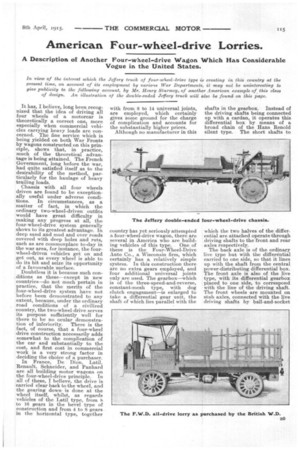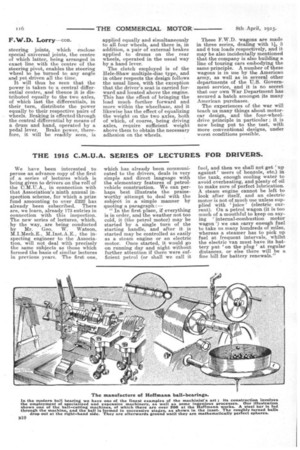American Four-wheel-drive Lorries.
Page 15

Page 16

If you've noticed an error in this article please click here to report it so we can fix it.
A Description of Another Four-wheel-drive Wagon Which Has Considerable Vogue in the United States.
In view of the interest which the Jeffery truck of four-wheel-drive type is creating in this country at the present time, on account of its employment by varions War Departments, it may not be uninteresting to give publicity to the following account, by Mr. Henry Sturmey, of another American example of . this class of design. An illustration of the double-ended Jeffery truck will also be found on this page.
It has, I believe, long been recognized that the idea of driving all four wheels of a motorcar is theoretically a correct one, more especially when commercial vehicles carrying heavy loads are concerned. The fine service which is being yielded on both War Fronts by wagons constructed on this principle, shows that, in practice, much of the theoretical advantage is being attained. The French Government, long before the war, had quite satisfied itself as to the desirability of the method, particularly for the haulage of heavy trailing loads.
Chassis with all four wheels driven are found to be exceptionally useful under adverse conditions. In circumstances, as a matter of fact, in which the ordinary two-wheel-driven outfits would have great difficulty in making any progress at all, the four-wheel-drive system generally shows to its greatest advantage. In deep sand and mud and over roads covered with deep holes and ruts, such as are commonplace to-day in the war area, for instance, the fourwheel-driven vehicles get on and get out, as every wheel is able to do its bit and seize its opportunity of a favourable surface.
Doubtless it is because such conditions as these—except in new countries—do not much pertain in practice, that the merits of the four-wheel-drive system have not before been demonstrated to any extent, because, under the ordinary road conditions of a civilized country, the two-wheel-drive serves its purpose sufficiently well for there to be no ocular demonstra tion of inferiority. There is the fact, of course, that a four-wheel drive construction necessarily adds somewhat to the complication of the car and substantially to the cost, and first cost in commercial work is a very strong factor in deciding the choice of a purchaser. In France, De Dion, Latil, Renault, Schneider, and Panhard are all building motor wagons on the four-wheel-drive principle. In all of these, I believe, the drive is carried clear back to the wheel, and the gearing downis done at the
wheel itself, whilst, as regards vehicles of the Latil type, from b to 16 gears in the bevel type of construction and from 4 to 8 gears in the horizontal type, together with from 8 to 14 universal joints, are employed, which certainly gives some ground for the charge of complication and accounts for the substantially higher prices.
Although no manufacturer in this
country has yet seriously attempted a. four-wheel-drive wagon, there are several in America who are building vehicles of this type. One of these is the Four-Wheel-Drive Auto Co., a Wisconsin firm, which certainly has a, relatively simple system. In this construction there are no extra gears employed, and four additional universal joints only are used. The gearbox—which is of the three-speed-and-reverse, constant-mesh type, with dog clutch engagement—is enlarged to take a differential gear unit, the shaft of which lies parallel with the
shafts in the gearbox. Instead of the driving shafts being connected up with a cardan, it operates this differential box by means of a broad chain of the Hans Renold silent type. The short shafts to which the two halves of the differential are attached operate through driving shafts to the front and rear axles respectively. The back axle is of the ordinary live type but with the differential carried to one side, so that it lines up with the shaft from the central power-distributing differential box. The front axle is also of the live type, with its differential gearbox placed to one side, to correspond with the line of the driving shaft. The front wheels are mounted on stub axles, connected with the live driving shafts by ball-and-socket steering joints, which enclose special universal joints, the centre of which latter, being arranged in exact line with the centre of the steering pivot, enables the steering wheel to be turned to any angle and yet driven all the time.
It will thus be seen that the power is taken to a central differential centre, and thence it is distributed equally to the two axles, of which last the differentials, in their turn, distribute the power equally to their respective pairs of wheels. Braking is effected through the central differential by means of a drum and band, operated by a pedal lever. Brake power, therefore, it will be readily seen, is applied equally and simultaneously to all four wheels, and there is, in addition, a pair of external brakes applied to drums on the rear wheels, operated in the usual way by a hand lever.
The clutch employed is of the Hele-Shaw multiple-disc type and in other respects the design follows the usual lines, with the exception that the driver's seat is carried forward and located above the engine. This has the effect of bringing the load much further forward and more within the wheelbase, and it likewise has the effect of equalizing the weight on the two axles, both of which, of course, being driving axles, require sufficient weight above them to obtain the necessary adhesion on the wheels. These F.W.D. wagons are made in three series, dealing with 11, 3 and 6 ton loads respectively, and it may be also incidentally mentioned that the company is also building a line of touring cars embodying the same principle. A number of these wagons is in use by the American army, as well as in several other departments of the U.S. Government service, and it is no secret that our own War Department has secured a batch amongst its many American purchases.
The experiences of the war will teach us many things about motorcar design, and• the four-wheeldrive principle in particular ; it is now being put to the test, with more conventional designs, under worst conditions possible.




















